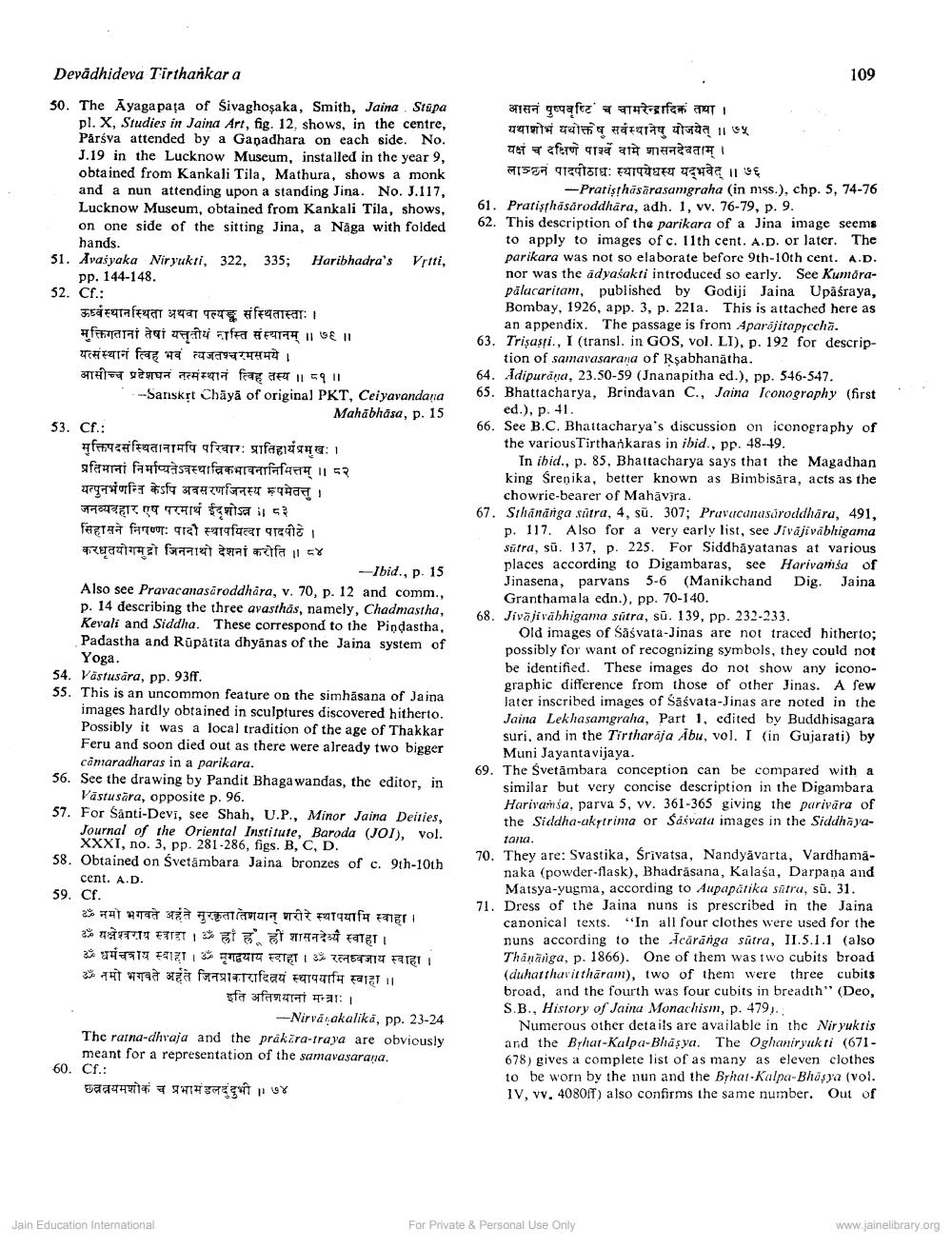________________
Devādhideva Tirtharkar a
109
50. The Ayaga paja of Sivaghosaka, Smith, Jaina Srapa
pl. X, Studies in Jaina Art, fig. 12, shows, in the centre, Parsva attended by a Ganadhara on each side. No. J.19 in the Lucknow Museum, installed in the year 9, obtained from Kankali Tila, Mathura, shows a monk and a nun attending upon a standing Jina. No. J.117, Lucknow Museum, obtained from Kankali Tila, shows, on one side of the sitting Jina, a Näga with folded
hands. 51. Avasyaka Niryukti, 322, 335; Haribhadra's Vriti,
pp. 144-148.
52. Cf.:
ऊर्ध्वस्थानस्थिता अथवा पल्यङ्क संस्थितास्ताः । मक्तिगतानां तेषां यत्ततीयं नास्ति संस्थानम् ॥ ७६ ॥ यत्संस्थानं त्विह भवं त्यजतश्चरमसमये। आसीच्च प्रदेशघनं तत्संस्थानं त्विह तस्य ॥ ८१॥ --Sanskrt Chāyā of original PKT, Ceiyavandana
Mahābhāsa, p. 15 53. Cf.:
मुक्तिपदसंस्थितानामपि परिवारः प्रातिहार्यप्रमखः । प्रतिमानां निर्माप्यतेऽवस्थाविकभावनानिमित्तम् ।। ८२ यत्पूनर्भणन्ति केऽपि अवसरणजिनस्य पमेतत्त् । जनव्यवहार एष परमार्थ ईदृशोऽन्न ।। ८३ सिंहासने निपण्णः पादौ स्थापयित्वा पादपीठे। करधृतयोगमुद्रो जिननाथो देशनां करोति ॥ ८४
- Ibid., p. 15 Also see Pravacanasäroddhāra, v. 70, p. 12 and comm., p. 14 describing the three avasthås, namely, Chadmastha, Kevali and Siddha. These correspond to the Pindastha, Padastha and Rūpåtita dhyānas of the Jaina system of
Yoga. 54. Vastusara, pp. 93ff. 55. This is an uncommon feature on the simhāsana of Jaina
images hardly obtained in sculptures discovered hitherto. Possibly it was a local tradition of the age of Thakkar Feru and soon died out as there were already two bigger
camaradharas in a parikara. 56. See the drawing by Pandit Bhagawandas, the editor, in
Vastusāra, opposite p. 96. 57. For Sänti-Devi, see Shah, U.P., Minor Jaina Deities,
Journal of the Oriental Institute, Baroda (JOI), vol.
XXXI, no. 3, pp. 281-286, figs. B, C, D. 58. Obtained on Svetämbara Jaina bronzes of c. 9th-10th
cent. A.D. 59. Cf.
ॐ नमो भगवते अहंते सुरकृतातिशयान् शरीरे स्थापयामि स्वाहा । ॐ यक्षेश्वराय स्वाहा । ॐ ह्रां ह्रह्रीं शासनदेव्यै स्वाहा । ॐधर्मचत्राय स्वाहा । ॐ मृगद्वयाय स्वाहा । ॐ रत्नध्वजाय स्वाहा । ॐ नमो भगवते अर्हते जिनप्राकारादिनयं स्थापयामि स्वाहा ।।
इति अतिशयानां मन्त्राः ।
--Nirvă akalikā, pp. 23-24 The raina-dhwaja and the präkära-traya are obviously
meant for a representation of the samavasarana. 60. Cf.:
छनत्रयमशोकं च प्रभामंडलदुंदुभी॥ ७४
आसनं पुष्पवृष्टि' च चामरेन्द्रादिकं तथा । यथाशोभं यथोक्तषु सर्वस्थानेषु योजयेत् ।। ७५ यक्षं च दक्षिणे पावें वामे शासनदेवताम् । लाञ्छन पादपीठाधः स्थापयेधस्य यद्भवेत् ।। ७६
--Pratisthāsārasamgraha (in mss.), chp. 5, 74-76 61. Pratishāsároddhāra, adh. 1, v. 76-79, p. 9. 62. This description of the parikara of a Jina image seems
to apply to images of c. 11th cent. A.D. or later. The parikara was not so elaborate before 9th-10th cent. A.D. nor was the adyasakti introduced so early. See Kumarapalacaritam, published by Godiji Jaina Upasraya, Bombay, 1926, app. 3, p. 221a. This is attached here as
an appendix. The passage is from Aparăjitaprocha. 63. Trisasi., I (transl. in GOS, vol. LI), p. 192 for descrip
tion of samavasarana of Rşabhanatha. 64. Adipurāņa, 23.50-59 (Jnanapitha ed.), pp. 546-547. 65. Bhattacharya, Brindavan C., Jaina Iconography (first
ed.), p. 41. 66. See B.C. Bhattacharya's discussion on iconography of the various Tirtharkaras in ibid., pp. 48-49.
In ibid., p. 85, Bhattacharya says that the Magadhan king Srenika, better known as Bimbisára, acts as the
chowrie-bearer of Mahāvīra. 67. Sthanäriga sutra, 4, sū. 307; Pravacanosároddhära, 491,
p. 117. Also for a very early list, see Jiväjivabhigama süfra, sū. 137, p. 225. For Siddhāyatanas at various places according to Digambaras, see Harivamia of Jinasena, parvans 5-6 (Manikchand Dig. Jaina
Granthamala edn.), pp. 70-140. 68. Jivāji räbhigama sutra, sū. 139, pp. 232-233.
Old images of Sāśvata-Jinas are not traced hitherto; possibly for want of recognizing symbols, they could not be identified. These images do not show any iconographic difference from those of other Jinas. A few later inscribed images of Sāśvata-Jinas are noted in the Jaina Lekhasamgraha, Part 1, edited by Buddhisagara suri, and in the Tirtharaja Abu, vol. I (in Gujarati) by
Muni Jayanta vijaya. 69. The Svetāmbara conception can be compared with a
similar but very concise description in the Digambara Harivainsa, parva 5, vv. 361-365 giving the parivāra of the Siddha-akytrima or Śasvata images in the Siddhaya
tana. 70. They are: Svastika, Srivatsa, Nandyavarta, Vardhama
naka (powder-flask), Bhadrâsana, Kalasa, Darpana and
Matsya-yugma, according to Aupapatika sūtru, sū. 31. 71. Dress of the Jaina nuns is prescribed in the Jaina
canonical texts. "In all four clothes were used for the nuns according to the Icaranga sutra, II.5.1.1 (also Thânäiiga, p. 1866). One of them was two cubits broad (duhartharitthāram), two of them were three cubits broad, and the fourth was four cubits in breadth" (Deo, S.B., History of Jaina Monachism, p. 479.).
Numerous other details are available in the Nir yukris and the Byhar-Kalpa-Bhasya. The Oghaniryukti (671 - 678) gives a complete list of as many as eleven clothes to be worn by the nun and the Bhar Kalpa-Bhasya (vol. IV, vv. 4080ff) also confirms the same number. Out of
Jain Education International
For Private & Personal Use Only
www.jainelibrary.org




